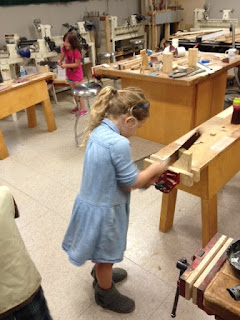 |
| Boring large mortises, first the edges and then the middle. |
From about 1840 - 1900, about a million Swedes emigrated to the US. Sweden had been a nation of peasant farmers, and as the population grew, farms were passed down to subsequent generations in ever smaller sizes. What had been a single family farm of 80 acres or more, was halved then quartered and then reduced to less than 1/8th or 1/16th its original size.
So, not only were Swedes suffering from a rise in the consumption of
brännvin, (every small farm had a still) they were overpopulated on small farms incapable of providing enough food. The rise of well-made manufactured goods from Germany and the UK diminished the value of home crafts, and the peasants could no longer support themselves by selling the objects they had crafted during long winter months.
 |
| Large tusks lock the mortise and tenon joints. |
Emigration to the US provided a much needed safety valve on population growth, and the Lutheran church endorsed Sloyd education to counter the tragic moral effects of a loss of traditional handcrafts.
Sloyd was introduced to raise the character and intelligence of the Swedish people during a time of rapid societal change, and the first Sloyd taught in the US was by Swedish immigrants to Minnesota. If you want more information on Sloyd, this link is to the first article I wrote about Sloyd in 2006:
Educational Sloyd.
I also wrote the original article about
Sloyd in Wikipedia. It has been expanded by others around my original core.
I've been at work on the table, forming large mortises to secure the two leg sections to the central cross brace. I used my rarely used horizontal boring machine to form the mortises, shaping them to an exact fit. Some minor chiseling was required, so I used my original Nääs chisel, now restored to original condition and sharp enough for another century.
I have been working in heavy walnut to build the table, but the real heavy work has been taking place at ESSA. They used a crane to lift all the heavy timbers into place to build the new woodworking studio. It will be a remarkable structure.
On the national front, donald J. trump now has launched a new arms race with the threat of expanding our capacity to annihilate civilization as we know it. His minions are now trying to say, "No, he didn't mean that." But he's saying "yes he did." Then China told trump that if he really wants a trade war, they will start by targeting Republican states. Arkansas is one of those, and the Republicans have earned what they get. Incidentally, For all those Walmart shoppers, the Walmart headquarters are in Bentonville, Arkansas, just 40 miles from Eureka Springs. If China targets just the state of Arkansas, Walmart shoppers throughout the US will notice rising prices.
Republican senator John McCain had said you really have to listen to the trump for two days in a row and not take any given tweet as being trump's true position until it's been repeated on day two. The man is truly delusional, has gone into his second day of proposing a new arms race and civilization will suffer from people having been fooled by trump, Russia and the FBI during the last election.
For those who read here daily in the hopes of escaping politics, my condolences.
Make, fix, create and thus increase the likelihood that others learn likewise.














































